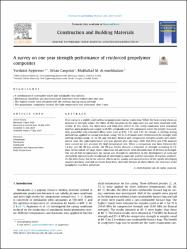| dc.contributor.author | Aygörmez, Yurdakul | |
| dc.contributor.author | Canpolat, Orhan | |
| dc.contributor.author | Al-Mashhadani, Mukhallad M. | |
| dc.date.accessioned | 2020-11-28T20:57:46Z | |
| dc.date.available | 2020-11-28T20:57:46Z | |
| dc.date.issued | 2020 | en_US |
| dc.identifier.issn | 0950-0618 | |
| dc.identifier.issn | 1879-0526 | |
| dc.identifier.uri | https://hdl.handle.net/11363/2506 | |
| dc.description.abstract | Heat curing is a widely used method in geopolymer mortar production. While the heat curing shows an increase in strength values, the effect of this situation in the long term has not been examined sufficiently. In this study, the short-term and long-term effects of the curing conditions were examined together and a geopolymer sample with 90% metakaolin and 10% colemanite waste (by weight) was used. Also, polyolefin and polyamide fibers were used as 0.5%, 1.0%, and 1.5%, by volume. A wetting-drying method was applied for curing with heat curing. The Si-O-Al bonds were established to be stronger with wetting-drying curing. 14, 56, 90, and 365 days' flexural and compressive strengths results were determined. Also, the high-temperature test was applied after 365 days. SEM, TGA-DTA, and FTIR analyses were carried out pre and post the high-temperature test. When a comparison was done between the 14-day and the 90-day results, the 90-day results showed a reduction of strength according to 14-days. At the end of 365 days, these reductions fell and results were obtained close to 90 days of strength. The use of high-temperatures for curing was thought to contribute to the development of early-age strength by supporting the dissolution of solid binding materials and the formation of reaction products. On the other hand, due to the adverse effects on the quality and microstructure of the rapidly developing reaction products, strength decreases have been observed. Despite all these effects, the structure of the geopolymer has been preserved. | en_US |
| dc.description.sponsorship | This work was supported by the research fund of the Yildiz Technical University, the authors would like to express their sincere gratitude to scientific research coordination unit for their financial support to the project (Project number: FBA-2017-3081). | en_US |
| dc.language.iso | eng | en_US |
| dc.publisher | ELSEVIER SCI LTD, THE BOULEVARD, LANGFORD LANE, KIDLINGTON, OXFORD OX5 1GB, OXON, ENGLAND | en_US |
| dc.relation.isversionof | 10.1016/j.conbuildmat.2020.120267 | en_US |
| dc.rights | info:eu-repo/semantics/openAccess | en_US |
| dc.rights | Attribution-NonCommercial-NoDerivs 3.0 United States | * |
| dc.rights.uri | http://creativecommons.org/licenses/by-nc-nd/3.0/us/ | * |
| dc.subject | Geopolymer | en_US |
| dc.subject | Metakaolin | en_US |
| dc.subject | Colemanite | en_US |
| dc.subject | Polyolefin and Polyamide Fibers | en_US |
| dc.subject | High-Temperature | en_US |
| dc.subject | FLY-ASH | en_US |
| dc.subject | MECHANICAL-PROPERTIES | en_US |
| dc.subject | FIRE RESISTANCE | en_US |
| dc.subject | CEMENT MORTAR | en_US |
| dc.subject | METAKAOLIN | en_US |
| dc.subject | TEMPERATURE | en_US |
| dc.subject | BEHAVIOR | en_US |
| dc.subject | WASTE | en_US |
| dc.subject | KAOLIN | en_US |
| dc.title | A survey on one year strength performance of reinforced geopolymer composites | en_US |
| dc.type | article | en_US |
| dc.relation.ispartof | CONSTRUCTION AND BUILDING MATERIALS | en_US |
| dc.department | Mühendislik ve Mimarlık Fakültesi | en_US |
| dc.identifier.volume | 264 | en_US |
| dc.relation.publicationcategory | Makale - Uluslararası Hakemli Dergi - Kurum Öğretim Elemanı | en_US |



















